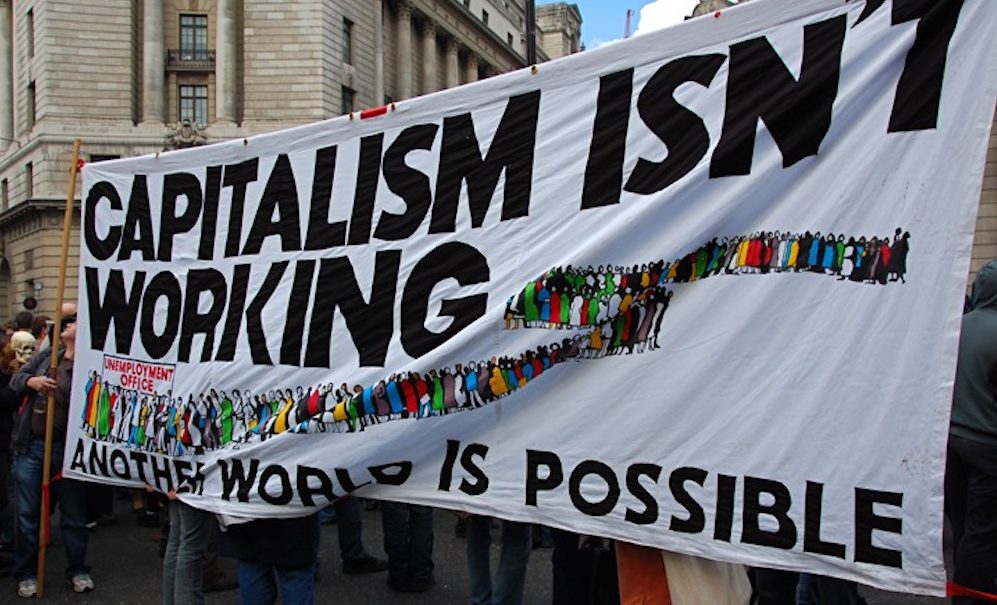What kind of capitalism is it possible for the left to build?

Image: Tony Hall, CC BY 2.0

To win power, the left must build a narrative around ending privatisation, empowering the workforce and borrowing to invest. To stay in power, left governments must transition towards an economy based on high automation, shorter working hours and free services.
***
After Trump, Brexit, the formation of a right wing coalition in Austria and now the M5S/Lega government in Italy, the way the current era might end is becoming clearer. Right wing populism demands an end to migration and offshoring. Right wing conservatism, in response, harnesses the populist into a programme of nation-centric free-market economics – call it “Thatcherism in One Country”.
Meanwhile, Russia’s perennial hybrid warfare against Western democracies opens up the social fissures within them even further.
The G7’s failure to commit to a “rules based global order” after Trump’s walkout then presages the actual paralysis of multilateral institutions. At worst the EU, NATO and the Eurozone fall apart.
Of course, it’s possible to imagine that the populists, the demagogues and their right wing, authoritarian voters suddenly become exhausted and satisfied with the world as it is. But it is much easier to imagine that the anger of their voters escalates, that democratic institutions become frayed and discredited, and that the nerves of liberal technocrats crack.
Either way, the project I am trying to outline in this series – namely the programme, philosophy and moral basis for a radical social democracy in the 21st century – has increasingly to be conceived as a plan for picking up the pieces, not the deepening and extension of an essentially stable system.
In my book ‘Postcapitalism’, I argued that information technology creates the possibility of a long transition beyond market-based societies towards an economy based on relative abundance, high automation, low work and free utility produced by network effects. This remains, for me, the 21st century equivalent of the “maximum programme” adopted by social-democracy in the 1890s.
However, the crisis of the short-term demands answers – and better ones than the re-treaded Keynesianism on offer from the traditional social-democratic left.
A programme of immediate, “minimum” actions and principles – which social democratic parties across Europe and North America could sign up to – would have at its heart two twin aims:
1. to revive economic growth, prosperity and social cohesion in Western democracies; and
2. to defend and deepen their democratic rights and institutions.
It would also need to contain elements of “transition” – though not of the kind originated by the Communist International in the 1920s and later associated with Trotsky’s Fourth International. Then the aim was to introduce elements of planning and workers control into the programmes of left governments, moulded around scarcity. Today the transition path has to embrace the potential for abundance contained in information technology and, of course, to deal with climate change as an urgent issue.
So the core issue for those who want to radicalise social democracy is: what kind of capitalism is it possible for us, in these conditions, to create?
Before attempting an answer I want to recapitulate the argument of my previous essays in this series for openDemocracy:
- To solve the problem of working class atomisation, and create a narrative for social democracy, the British Labour party and other social-democratic parties should focus their efforts on achieving a tangible upward movement in incomes, health, lifestyles and prospects for working age adults over the next 10 years.
- To solve the problem that globalisation empowered corporations while limiting the sovereignty of electorates, we must be prepared to retreat from extreme globalisation, into a “second trench”, consisting of national economic policymaking in the context of international solidarity, abandoning certain supranational regulations deemed currently to have the force of eternal law.
- To solve the problem of agency, we need to understand that oppression and exploitation take many forms in late-neoliberal capitalism, and that the movement to deliver a progressive government will most likely be a tribal alliance of people adversely affected. In that alliance, the traditional working class and labour movement structures will exist, but will not have hegemony; where working class culture has been inverted into a form of nostalgic ethno-nationalism, the movements and demands it produces will have to be resisted.
In Britain, the practical implications of the above are for Labour to seek a progressive electoral or governmental alliance with the Greens and left nationalists; for a rapid rise in real disposable incomes to be the number one deliverable of a progressive government; and for that government to fight for the reform of all multilateral treaties or obligation that stand in the way of social justice – whether it be the EU or the World Trade Oraganisation.
But what, practically, should a left-wing government do, and in what sequence? The answer to this is not obvious from reading Labour’s 20,000 word 2017 general election manifesto – detailed though it was, nor from the 100+ bullet points that formed the manifesto of Podemos. Nor even the 83 chapters of L’Avenir En Commun, on which Jean-Luc Melenchon fought for the French presidency in 2017.
None of these documents reads like a battle plan; in fact, they read more like an infantry manual full of standard procedures, rules and principles. None was likely to survive contact with the enemy if the parties that produced them had gained power.
To transform capitalism rapidly in the direction of democracy and social justice, you need a linked series of actions – and a project-management understanding of their synergies and interrelationships.
***
Day One
What should a left-wing British Labour government – or a Podemos-PSOE coalition, or a France Insoumise presidency supported by the trade unions and the remnants of the socialist party – do on their first day in office? The obvious answer is: survive the financial market backlash. If you observe the market turmoil caused by the possibility of a far-right/populist alliance in Italy, you get a taste of what’s in store for a government of the radical left.
The clear danger lies not just in the kind of capital flight experienced by France under Mitterrand in 1981-83, but flight on a scale resembling the “sudden stop” phenomenon that plagued Latin America and parts of Asia in the mid-1990s, and which have re-emerged in the post 2008 period (sudden stops have been defined as a sudden reversal of capital inflows causing GDP to decline by the order of around 6% in a twelve month period).
Almost everywhere a left government is conceivable, financial markets would be capable of mixing a rational aversion to risk with speculative and politically-motivated capital movements to cause the currency to plummet, growth to tank, and foreign exchange reserves to be depleted, demanding central bank action to counteract the declared programme of the winning party.
It is this – not a rerun of the coup against Allende in Chile in 1973 – that left governments need to be ready for.

François Mitterrand during the 1981 presidential campaign. Image: Jacques Paillette, CC BY-SA 3.0
Of the four remedies usually chosen to combat a sudden stop – fiscal policy, monetary policy, currency depreciation and pro-market structural reform – the last is a non-starter for a left government. With capital controls ruled out except in extreme circumstances, any left party contemplating power has to wargame how it might use reserves, monetary policy, fiscal expansion and currency maneuvers to sit tight through the average three to four quarters most sudden stop episodes last for.
I don’t intend to wargame such tactics here. They would have to be highly time and country specific. Suffice to say, as left governments appear on the brink of power, their right wing nationalist and neoliberal centrist opponents are likely to try to tie their hands, for example by running down reserves.
What is certain however, is that from Day One a left government taking power has to give as many people as possible “skin in the game” of its survival.
Fortuitously, the neoliberal model of capitalism has over the past 30 years depleted the amount of power wielded by parliaments in favour of executive power. Though the medium-term aim of a left government would be to reverse this trend, the Day One question would be: what is possible through urgent ministerial action?
Let’s take the example of the UK. Here, ministers can, technically, order their departments to do anything that is not illegal or forbidden by treaties. However, a huge realtime audit power is given to senior civil servants by their role as “accounting officers” for each department. They can object to ministerial actions and have frequently done so, most commonly on grounds of “value for money”. If not doing something is cheaper than doing it, or if a minister is proposing to pursue anything other than the value for money option, the permanent secretary can object, requiring the minister to issue a “direction”, which then becomes a public cause célèbre.
In the case of a left-led Labour government in the UK, it’s not hard to imagine the process becoming weaponised: one minister after another clashing publicly with their civil servants over whether a state investment bank, state aid to a steel works, or the choice of a public healthcare provider over Richard Branson, is “value for money”. This power, in other words, would lie in the hands of civil servants even after Brexit. Without Brexit, the rules of the single market would simply give the permanent secretary added justification.
However, the definition of value for money lies entirely in the hands of the Treasury. Though the National Audit Office is headed by an officer appointed by the Queen, the value for money guidelines (last issued in 2004) are drawn up by HM Treasury.
So the most far-reaching thing a left Labour government could do on Day One would be to set out new value for money rules aligned with the macroeconomic philosophy of its new Treasury economics team, which recognises the power of public spending multipliers to stimulate growth in excess of the sum outlaid.
This revised philosophy on public spending would ripple through Whitehall in the space of a few days. It would probably ruffle a few people’s people’s feathers, above all the National Audit Office which has been working to different guidelines. But it would remove one of the classic neoliberal objections to ministerial actions. It would free individual departments to take operational decisions in pursuit of short term objectives.
First 100 days
What might these be? If things go wrong, the answer could easily end up as: a set of reactive or piecemeal measures designed to address long-held grievances, or assuage public opinion. Or measures that make sense in the long-term but deliver very little “skin in the game” for the electorate that has installed the left-wing government in the first place.
To make things go right for a left government in its first few weeks, you have to understand the strategic objective: to change the dynamics of the whole British economy so that if ever a right wing government returns to power it will, as the Tories did in 1951, accept large parts of what the left has achieved as the foundation for a new consensus.
With this in mind here are the five things I would urge a Corbyn/Sturgeon government in the UK, or a Sanchez/Iglesias government in Spain, or Democrat government in the US under Bernie Sanders to do in the first 100 days:
1. Switch off the neoliberal privatisation machine. This is not yet about reversing existing privatisations but declaring that there will be no new ones, and stating that outsourcing will no longer be done on the cheapest-wins basis, or by preferring private over public provision. The government should state that its preference is for essential public services to be provided by publicly-owned bodies and that the market, and any competition rules required by the EU, NAFTA or WTO, will be worked-around. Furthermore, existing privatised utilities and monopolies, once renationalised, will not be run as profit-making corporations but with the aim of providing social value in the form of cheaper energy, cheaper rail travel, higher wages, and of creating templates for new forms of social ownership at large scale such as co-operatives, platform co-operatives, credit unions, ethical banks and benefit corporations.
2. Publish, and therefore signal the imminence of, a basic package of new labour rights to be legislated without consultation. The consultation stage was the election, should be the argument. The new rights should be a mixture of individual and collective:
- With regards to individual rights, the aim would be massive, free and easy access to the justice system, whereby individual workers can enforce their human rights against employers. Though in the UK it would require reversal of legislation from the neoliberal era, ministerial directives could do a lot of the work up front.
- With regards to collective rights, the removal of exemptions for small businesses, and for people in post for less than an arbitrary time limit would be easy game changers before primary legislation takes place. An employment minister turning up at McDonalds, TGI Fridays or Pret A Manger, with the cameras but unannounced, to tell the workforce that within six months they will have the right to a living wage, union representation on the board, collective wage bargaining, paid holidays and maternity leave could have as much effect on behavioural change as the legislation itself.
- The issue of bogus self-employment, which plagues industries as diverse as construction, hairdressing and journalism could be addressed by the relevant Treasury surveillance department having its staff tripled and bonuses paid for successful prosecutions of the relevant employers. Since the business model of these sectors would have to change, it would require a transition period to get the relevant workforce on the books, paying the right taxes and receiving the right benefits. But the early signal should trigger rapid behaviour change among all those businesses that intended to survive.
3. Set up an Infrastructure Commission. The UK already has a National Infrastructure Commission which advises on long-term projects, but a progressive solution would be to set one up with executive powers, allied to a state investment bank to raise and spend the money. While it might take more than 12 months to legislate and raise money for a state investment bank, and get regulatory clearance from the EU, the Treasury could require a sub-department to begin operating in the shadow of the intended bank immediately, assessing the likely funding decisions, modelling the outcomes etc. Meanwhile, the Infrastructure Commission should, drawing together major sectors, cities and town governments, determine the detailed plan to spend billions borrowed under new rules which allow borrowing for investment.
To the extent that a Labour – or Spanish or French left government – remained under the tutelage of the European Union, it would have to press for the reform of the Maastricht criteria or secure opt-outs from them – above all exempting borrowing to invest from the deficit limits. A US left government would, as long as it controlled Congress, face very few obstacles to enacting a major fiscal stimulus, unless China decided to use the extra borrowing to trigger a currency and debt showdown. In the medium-term, the success of such projects would be indicated by whether they began to transform blighted communities, not by the kilometres of motorway or railways upgraded. However, the major signalling job has to be done upfront. The private sector – both domestic and international – should react positively to a clear, irreversible long-term signal from government to upgrade not only the physical infrastructure but the social and environmental situations. The earlier and clearer it is given the better.
4. Change the remit of the central bank. For left governments in the Eurozone this would need a prolonged and co-ordinated struggle to reform the ECB. In Britain and the USA, much of it could happen through a letter from the finance minister. The principles of a post-neoliberal remit for, say, the Bank of England are not hard to design. They should be:
- Non-intervention in fiscal policy: then Bank of England governor Mervyn King once threatened to counteract any fiscal stimulus by the Brown government in excess of what he deemed strictly necessary to maintain inflation at around 2%. Such reasoning should be explicitly excluded, demoting the central bank from its high perch in the neoliberal hierarchy.
- A policy to promote mild inflation: under neoliberalism, because the implicit fear was of a wage take-off which never materialised, central banks like the Bank of England always put the brakes on growth and never put the brakes hard enough on recessions.
- Macroprudential regulation: i.e. spotting and preventing boom-bust cycles and the failure of systemic banks, roughly as now only with more political transparency and prejudice in favour of early intervention.
And that’s it. You would also need an industrial policy, but as I outlined in the previous essay if you want to keep a roughly multilateral and global system the industrial policy more or less writes itself: move legacy industries up the value chain, build “human capital” (i.e. skill and wage-earning potential) and keep some core industries, like steel, energy and defence manufacturing onshore and domestically owned for reasons of national security (in a deteriorating global environment).
Industrial policy and a long-term fiscal expansion would pay their dividends over five to ten years, not 90 days. But the combination of ending privatisation, empowering the workforce, borrowing to invest in infrastructure and subordinating the central bank to the national economy’s interests, not the global elite’s doctrines, are the four big pumps a left government needs to make work.

“McStrike” in Crayford, 2017. Image: War on Want, CC BY 2.0
Hard as it may be for some Corbynistas to accept, the rest is basically tactical. Whether to bring all state-owned housing back under the control of councils or to incentivise the housing associations to deliver the same result; whether to build a tidal lagoon at Swansea or a nuclear power station at Hinkley Point – these are legitimate matters of debate inside the left, mobilising interest groups, obsessions and differing priorities. But they are secondary issues when it comes to implementing a new model, stabilising the country’s position within a fragmenting global system and giving the mass of people “skin in the game”.
The problem is, even as you revive a high-growth, high-wage, state-led economic model in northern-hemisphere countries, across the whole of the developed world the dynamics I described in ‘Postcapitalism’ are inescapable. It is these that make classic Keynesian expansion programmes unsuitable for the 21st century.
How technology alters the medium term agenda
There are four main processes triggered by information technology which, medium term, left governments have to construct responses to. They are:
- the collapsing cost of production of everything that is touched by infotech, which then disrupts the price mechanism itself (making things cheap or free);
- the delinking of work from wages, which allows leisure time and labour to bleed into one another, promoting massive under-employment and – at the bottom of the labour market – precarity;
- the emergence of new, positive, network effects, producing new use-values on an exponential scale, which are not prima-facie the property of any company or individual; and
- massive asymmetries of information, and therefore power.
As I argued in ‘Postcapitalism’, these processes fundamentally challenge the property relations on which the market system rests. In response, over the past 15 years, the following structural mutations have taken place, which a left government would need to deal with:
- The zero-marginal cost effect, which calls into being vast monopolies like Facebook, Google, IBM and Microsoft whose sole aim is to suppress price formation.
- The possibility of rapid automation, which calls forth its opposite: mass precarity and under-employment. Today we create millions of jobs which do not need to exist, just to include the low paid in the more lucrative mechanisms of exploitation, namely the credit system and social media (via the smartphone)
- Network effects, dubbed positive externalities by economists, which are captured by information monopolies, preventing the socially useful exploitation of user data except where it is useful to the monopolies.
- New information asymmetries, which market theory says should be eroded by competition, are institutionalised with copyright, IP and patents extended ad infinite by the power of global corporations, and with the mass of small investors permanently disempowered compared to the large, niche, unaccountable ones.
From this contrast between the potential of the information economy and its malformed present arises the need for a programme of transition which radical social democracy should graft onto – and indeed into – the more traditional measures outlined above. It should include:
1. Breaking up or nationalising information monopolies, like Facebook and Amazon, so that price competition can bring the cost of information goods closer to zero.
2. Subsidising a programme of rapid automation with taxpayer-funded basic services and basic incomes: transport, education to degree level, healthcare and housing should be at a basic level free and beyond that cheap.
3. Outlawing the seizure and colonisation of collective user data by the IT industry and make data a public good. Empower citizens to tweak and control the conditions under which private companies own and exploit their data, using mechanisms such as the blockchain. This is the principle behind current trials both in Barcelona and Amsterdam, and if generalised would represent a major reversal and limitation of the power of the info-monopolies.
4. Enacting a new, universal human right to information symmetry: “no decisions about me, without me”, if translated into the information sphere, would force global corporations to cease building business models on the basis of permanent asymmetry of power and information. Algorithms should be transparent, and artificial intelligence deployed only with informed consent and under strict ethical guidelines. Data privacy should be a fundamental human right, and flouting it should lead to the termination of a corporation’s licence to operate.
Though breaking up the tech monopolies costs you nothing (apart from political grief), the move to a basic income and services model, paid for out of taxation, would demand a major rebalancing of the tax system in favour of redistribution. Winning the argument for this becomes the key objective of a radical social democracy. Consequently, squandering redistributive taxation measures in pursuit of the pet social-democratic objectives should be, where possible, avoided.
Instead of relying on redistributive tax measures, a sovereign state like Britain, the USA or the Eurozone has the ability, using its central bank, currency and new borrowing, to fund the “Keynesian” half of what I propose here. The other half – the massive cheapening of goods and services required to make everyday life with low work hours – is what needs new, redistributive taxation.
“Your kids go to school, your healthcare becomes world class, your journey to work cheap and your home affordable… and Facebook, Google, Deutsche Bank and some hedge funds pay for it,” is a narrative that I think, if confidently outlined, could allow the radical left to breakthrough into government across the developed world. Especially once the ethnic-utopias of the demagogic right deliver, as expected, only tears and disappointment.

Facebook CEO Mark Zuckerberg meets members of the European Parliament. Image: European Parliament, CC BY-NC-ND 2.0
For Labour in Britain, the art of winning the next election revolves around switching off the scatter gun of progressive promises and building a tight narrative around economic transformation, wage growth and the right to free basic services. The fact that the left controls the spray gun, not the right, does not solve the essential problem RH Tawney pointed to in the 1930s: either Labour has a clear strategy or it has a shopping list written by a committee.
Tawney’s survey of Labour under George Lansbury in 1934 described Labour’s programme then as “a glittering forest of Christmas trees with presents for everyone, instead of a plan of campaign for… a pretty desperate business”.
Tawney advised Labour’s hierarchy to set out the kind of society it wanted to establish, the kind of resistance expected, and the mechanisms needed to overcome that resistance. Though Podemos and France Insoumise are equally guilty of the “forest of Christmas trees” approach, it should be said that their leaders have made no bones about the need for mass organisations focused on overcoming resistance.
***
The first half of the strategy I have proposed here draws on classic Keynesianism but goes way beyond it: it requires a revolution in thinking about the central bank; the removal of market-oriented culture across government; and the explicit adoption of a high wage and moderately pro-inflation policy that could, over time, begin to de-financialise society. And the imposition of new macroeconomic thinking in key government departments so that the likely positive effects of borrowing, spending and printing money are factored in.
The second half, though more future oriented, has fewer policy shibboleths to overcome. The art of staying in government, and delivering irreversible change, revolves around how much of this new, transitional strategy Labour (or any other left social democracy) can manage to insert into its change programme in the first five years.
Suppose it goes right. What could a radical left government expect to achieve in four or five years?
In week one and month one: survive the financial backlash and mobilise the people by giving them clear, tangible things to defend. In the first year, kickstart growth and wage growth through fiscal and monetary expansion. In years two to five, allow infrastructural investment and human capital growth take over and, if possible, produce a sustainable upswing. Meanwhile, begin the microeconomic transformation to the new kinds of business model, ownership and technology regulations that are needed to allow the move to a shorter-hours, higher welfare economy.
This is still only an outline. But it’s a clearer outline than the ones contained in any left manifesto in the past three years. The clearer and simpler the outline, the more easily it can be communicated to the managers, civil servants, trade union/community activists and entrepreneurs who will have to respond to it.
I can anticipate numerous objections – and will deal with them if people respond to this essay. But to one objection I want to be brutally honest in advance.
Is this strategy designed to allow the populations of the developed world to capture more of the growth projected over the next 5-15 years, if necessary at the cost of China, India and Brazil having to find new ways to break out of the middle income trap? Would it, in other words, flatten out and reverse the trends captured in Branko Milanovic’s famous “elephant graph” over the next two decades?
For me the answer is yes. This is a programme to save democracy, democratic institutions and values in the developed world by reversing the 30-year policy of enriching the bottom 60% and the top 1% of the world’s population.
It is a programme to deliver growth and prosperity in Wigan, Newport and Kirkcaldy – if necessary at the price of not delivering them to Shenzhen, Bombay and Dubai.









